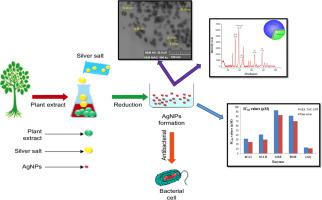Advanced Powder Technology ( IF 4.2 ) Pub Date : 2020-06-03 , DOI: 10.1016/j.apt.2020.05.020 Nesrin Korkmaz , Yusuf Ceylan , Parham Taslimi , Ahmet Karadağ , Ali Savaş Bülbül , Fatih Şen

|
Powder technology covers many fields from medicine to material science. Especially easy synthesis of nano- and micro-sized particles and low-cost synthesis with non-toxic chemicals are essential. The ability to design nanoparticles according to the application area and desired features is an advantage for many applications. Nanoparticles biosynthesis is under research due to broad biomedical practise. To synthesize of silver nanoparticle from the plant extract, Corylus avellana (Hazelnut) leaves were utilized for bioreduction of silver nitrate. The plant extract is thoroughly mixed with silver nitrate solution, studied the synthesis of nanoparticles using UV–Vis spectroscopy. The nanoparticles were characterized by SEM and XRD-Pattern. XRD analysis proved that the size range of the nanoparticles was 32 nm. Scanning microscope images also demonstrate nanoparticles having spherical shape and a mean size between 9 nm and 50 nm. The antibacterial effect of AgNPs obtained from hazelnut leaves demonstrated antibacterial effect against all tested bacteria strains. The results demonstrated that the plant extract acts as a good bioreductant for the production of silver nanoparticles. This compound was good inhibitor of the α-glycosidase, human carbonic anhydrase I and II isoforms, and cholinesterase enzymes. The results were obtained with Ki values of 12.84 ± 0.41 µM for α-glycosidase, 27.94 ± 3.77 µM for hCA I, 36.12 ± 6.03 µM for hCA II, 47.05 ± 6.83 µM for BChE, and 53.94 ± 7.55 µM for AChE, respectively.
中文翻译:

生物纳米银:合成,表征,抗菌,抗生物膜和酶活性
粉末技术涵盖了从医学到材料科学的许多领域。纳米和微米级颗粒的特别容易合成以及使用无毒化学品的低成本合成至关重要。根据应用领域和所需特征设计纳米颗粒的能力是许多应用的优势。由于广泛的生物医学实践,正在研究纳米颗粒的生物合成。为了从植物提取物中合成银纳米颗粒,可使用榛子叶(榛子)进行硝酸银的生物还原。将植物提取物与硝酸银溶液充分混合,使用UV-Vis光谱研究了纳米颗粒的合成。纳米颗粒通过SEM和XRD图谱表征。XRD分析证明纳米颗粒的尺寸范围是32nm。扫描显微镜图像还显示出具有球形形状并且平均尺寸在9nm至50nm之间的纳米颗粒。从榛子叶中获得的AgNPs的抗菌作用显示出对所有测试细菌菌株的抗菌作用。结果表明,植物提取物可作为生产纳米银的良好生物还原剂。该化合物是α-糖苷酶,人碳酸酐酶I和II同工型以及胆碱酯酶的良好抑制剂。获得的结果分别是:α-糖苷酶的Ki值为12.84±0.41 µM,hCA I的Ki值为27.94±3.77 µM,hCA II的Ki。值为36.12±6.03 µM,BChE的Ki。值为53.05±6.83 µM,AChE的53.94±7.55 µM。从榛子叶中获得的AgNPs的抗菌作用显示出对所有测试细菌菌株的抗菌作用。结果表明,植物提取物可作为生产纳米银的良好生物还原剂。该化合物是α-糖苷酶,人碳酸酐酶I和II同工型以及胆碱酯酶的良好抑制剂。获得的结果分别是:α-糖苷酶的Ki值为12.84±0.41 µM,hCA I的Ki值为27.94±3.77 µM,hCA II的Ki。值为36.12±6.03 µM,BChE的Ki。值为53.05±6.83 µM,AChE的53.94±7.55 µM。从榛子叶中获得的AgNPs的抗菌作用显示出对所有测试细菌菌株的抗菌作用。结果表明,植物提取物可作为生产纳米银的良好生物还原剂。该化合物是α-糖苷酶,人碳酸酐酶I和II同工型以及胆碱酯酶的良好抑制剂。获得的结果分别是:α-糖苷酶的Ki值为12.84±0.41 µM,hCA I的Ki值为27.94±3.77 µM,hCA II的Ki。值为36.12±6.03 µM,BChE的Ki。值为53.05±6.83 µM,AChE的53.94±7.55 µM。人碳酸酐酶I和II异构体,以及胆碱酯酶。获得的结果分别是:α-糖苷酶的Ki值为12.84±0.41 µM,hCA I的Ki值为27.94±3.77 µM,hCA II的Ki。值为36.12±6.03 µM,BChE的Ki。值为53.05±6.83 µM,AChE的53.94±7.55 µM。人碳酸酐酶I和II异构体,以及胆碱酯酶。获得的结果分别是:α-糖苷酶的Ki值为12.84±0.41 µM,hCA I的Ki值为27.94±3.77 µM,hCA II的Ki。值为36.12±6.03 µM,BChE的Ki。值为53.05±6.83 µM,AChE的53.94±7.55 µM。











































 京公网安备 11010802027423号
京公网安备 11010802027423号